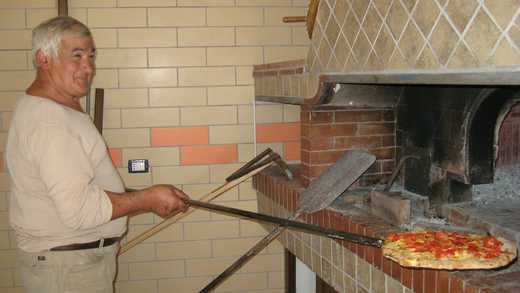How To Order Pizza In Italian (Essential Words And Phrases)
 Written byGiulietta Giordano
Written byGiulietta Giordano- Read time10 mins
- Comments0

Imagine you’re walking around the narrow alleys of a medieval Italian town and, suddenly, have a heavenly sight: a steaming hot pizza, all tomato, mozzarella and basil, being pulled out of a stone oven and served to an awaiting customer.
This will most likely make you experience l’acquolina in bocca (drooling!), especially if it’s mealtime (or not).
But how do you get the complete, authentic pizza experience?
Trust me, it all starts with knowing how to order. It’s not as easy as just pointing and trying to say words in an Italian accent.
To learn how to order at a pizzeria, you need some basic vocab and expressions. And I’m here to help you learn just that.
So, let’s start!
You’ll be surprised how much your pizza-eating habits will improve just by following this guide on how to order pizza in Italian.
First things first: Arriving at a pizzeria
Once you choose the pizzeria or restaurant you prefer, you’ll need a few expressions to find a table and settle down, ready for your pizza experience.
First of all, always greet the waiter or waitress who welcomes you! In Italy we put a lot of emphasis on friendliness and politeness, so be sure you give the proper attention to the people serving you.
Start with a polite buongiorno (good morning / afternoon) or buonasera (good evening) and you’ll never go wrong. If it’s an informal, young environment, even just a ciao and a smile will do.
Then, the waiter will probably ask something in the lines of quanti siete? (how many of you?), to which you can answer siamo in… (it’s … of us).
If you want to start the conversation, on the other hand, just say:

Un tavolo per due/tre/quattro, per favore.
Here’s a list of some more expressions you will find useful:
| Italiano | English |
|---|---|
| Avete prenotato? | Did you book? |
| Abbiamo una prenotazione a nome di… | We have a reservation under the name… |
| Ci sono tavoli in terrazza? | Are there any tables on the terrace? |
| Avete delle pizze vegane? | Do you have vegan pizzas? |
Ordering a pizza in Italian
Finally, here we are.
Now you’ve studied the menu and know exactly what you want… To start, well, you need to actually know how to say “I want”.
Sure, if you know your irregular conjugations of modal verbs, it’s easy enough: io voglio… (I want…).
Is it that easy, though?
Of course, you can use it and many people do, especially in informal situations, but there are other expressions that are far more common. Here they are!
How to say “I want” (a pizza) in Italian
| Italiano | English |
|---|---|
| Vorrei… | I would like… |
| Per me… | For me… |
| Io prendo… | I will have (lit. take)… |
| Mi porti… | Can you bring me… |
Use these expressions followed by una (one / a) and the name of the pizza. Here are some examples:
| Italiano | English |
|---|---|
| Vorrei una Capricciosa, per favore. | I would like a Capricciosa, please. |
| Per me una Diavola. | For me, a Diavola. |
| Io invece prendo una Margherita. | I will have a Margherita. |
| Mi porti una Quattro Stagioni? | Can you bring me a Quattro Stagioni? |
Polite words
Again, be friendly and polite! You probably already know these expressions, but revising them is always good.
- Per favore / per piacere / per cortesia (Please)
- Grazie / grazie mille (Thank you)
Also, using the conditional mood is a sign of politeness and respect in Italian, much like in English:
- Mi potresti portare il menù per favore? (Could you please bring me the menu?)
Customizing your pizza
Now that you know how to be friendly to the waiters and waitresses, and you know how to say “I want”, it’s time to actually learn how to order a pizza in Italian. To do it, you will need to learn two essential words without which there is no point ordering a pizza at all (ok, I am exaggerating a bit, but it’s kind of true!). Here are the words:
- Con (with)
- Senza (without)
Why are these so important, you might ask? Since Italians are picky about their pizzas, and they often make personal changes and customize their disk of dough.
So if you love Quattro stagioni, but are vegetarian, you’ll ask for a Quattro stagioni senza prosciutto (without ham).
On the other hand, if you like the classic Margherita, but want an extra touch of tomato, you might order a Margherita con pomodorini (margherita with cherry tomatoes).
Put no restraint to your imagination (and taste), you can ask for almost anything. Of course, if you decide to go for a Quattro formaggi con acciughe (Four Cheeses with anchovies), you might get strange looks, but they’ll probably make it anyway!
Here are some more expressions you might need to customize your pizza or ask other questions.
| Italiano | English |
|---|---|
| Si può aggiungere… | Can I add… |
| Me la puoi fare senza… | Can you make it without… |
| Puoi togliere… | Can you remove… |
| A inizio / fine cottura | Added before / after cooking. |
Extra native points
For extra native points, if you really want to sound like you know what you’re doing, try these expressions, too.
Allora…
Meaning: So…
When Italians start a sentence, and they’re still thinking about what they’re going to say, they often say allora… which can be translated as “so…”
When ordering a pizza, it is quite common to hear it at the beginning of a sentence.

Allora… Per me una Marinara… No, anzi, vorrei una Bufalina.
Cosa mi consigli (oggi)?
Meaning: What do you recommend (today)?
Not sure what you’re going for?
Just ask the waiter, they will always help and recommend fresh produce.
The formal version is cosa mi consiglia?
A posto così?
Meaning: Is this all?
This is what the waiter will ask once you’ve ordered everything.
You can either answer:

Sì, grazie, a posto così.
or

No, vorrei anche una porzione di patatine per favore.
Types of pizza
Let’s talk about flavors, finally.
Just to get our acquolina going a bit more. These are just some classic flavors; of course, there are many, many, many more!
Common types of pizza in Italy
Marinara

The simplest one.
Especially popular in the south of Italy: tomato, oregano, garlic, olive oil.
Margherita

The great classic.
Tomato, mozzarella, fresh basil, olive oil.
Napoli / Napoletana

From Naples.
Tomato, capers, anchovies, olive oil.
Funghi

The mushroom pizza.
Tomato, mozzarella, mushroom.
Quattro formaggi

Four types of cheese.
Usually mozzarella, gorgonzola, parmesan, and stracchino.
Quattro stagioni

Tomato, mozzarella, ham and black olives, mushrooms, olives, artichokes, basil.
Quattro stagioni means “four seasons”: tomato and basil for the summer, mushrooms for autumn, ham and olives for winter, and artichokes for spring!
Diavola

Means devil.
Tomato, mozzarella, spicy salami, olive oil.
Capricciosa

Tomato, mozzarella, mushrooms, artichokes, sausage or ham and, sometimes, egg.
A capriccio is a whim, so this pizza is made to satisfy all of your whims and fancies!
Main ingredients in Italian pizzas
If you’re using the great words con and senza to customize your pizza like any respectable Italian (everyone does it, so don’t be afraid to ask!), it’s important that you know the right words for the ingredients in Italian.
Here they are.
| Italiano | English |
|---|---|
| Mozzarella | mozzarella (ok, this is easy!) |
| Pomodoro / pomodorini | tomato / cherry tomatoes |
| Salame (piccante) | salami (spicy / pepperoni) |
| Olive | olives |
| Funghi | mushrooms |
| Prosciutto cotto / crudo | ham / parma ham |
| Capperi | capers |
| Carciofi | artichokes |
| Rucola | rocket |
| Basilico | basil |
TIP: If you order a Margherita con peperoni you will NOT get a pizza with tomato, mozzarella and round meat slices. If you want that, ask for salame and its variants. Peperoni actually means “peppers” in Italian!
Pizza al Taglio
Just a quick extra tip:
If you’re ordering in a “pizza al taglio” shop (pizza by the cut), things might be a little different.
Here you usually have the available pizzas on display, and you order one or more slices of those that are ready.
Here are some useful expressions:
| Italiano | English |
|---|---|
| Una fetta di… un pezzo di… | A slice of… a piece of… |
| appena sfornata | just out of the oven |
| Te la scaldo? | Shall I heat it up for you? |
| Mangi qua o porti via? | Will you eat here or take it away? |
| pizza da asporto | take away pizza |
Ordering a pizza in Italian
Now you know how to get a full pizza experience in Italian! What are you waiting for?
I hope this guide on ordering pizza in Italian was useful, and that it will help you to get exactly what you want in all the pizzerias you visit during your stay in Italy.
I think after all this pizza talk, I will head out for one of my favorites, a simple Marinara!
I’ll leave you with a small dialogue.
Italian dialogue in a pizzeria

Cameriere: Buongiorno!

Giulia: Ciao, vorrei un tavolo per due per favore.

Cameriere: Certo. Ecco qua. … Cosa vi porto?

Giulia: Per me una Capricciosa senza prosciutto, grazie. Ci puoi aggiungere anche dei pomodorini freschi a fine cottura?

Cameriere: Non c’è problema.

Luciano: Io vorrei una Margherita con mozzarella di bufala a inizio cottura, grazie.

Cameriere: Benissimo. Volete qualcosa da bere?

Giulia: Una bottiglia d’acqua naturale, per favore.

Cameriere: Ok. Siete a posto così?

Luciano: A posto così, grazie.
So that’s how you order a pizza in Italian!
Hopefully, you’ve gained enough vocabulary and expressions here to use at your local pizzeria.
Where to from here?
Take a look at some online Italian courses or apps to improve your Italian.
Good luck.
Did I miss something?
Comment below.
 Grab the link to this article
Grab the link to this article